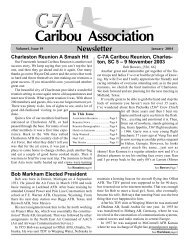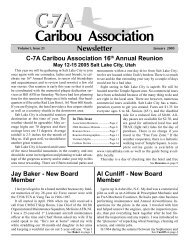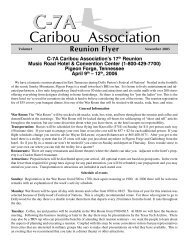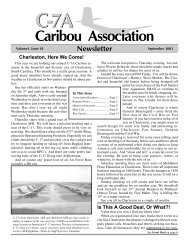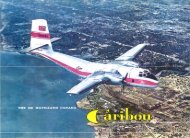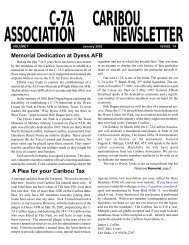Article from Airman magazine of October 1968 (PDF) - The C-7A ...
Article from Airman magazine of October 1968 (PDF) - The C-7A ...
Article from Airman magazine of October 1968 (PDF) - The C-7A ...
You also want an ePaper? Increase the reach of your titles
YUMPU automatically turns print PDFs into web optimized ePapers that Google loves.
W<br />
HO would want a cargo<br />
aircraft with only two engines<br />
(old-fashioned piston type at that); an<br />
aircraft that grosses out with a mere<br />
5,000 pounds <strong>of</strong> cargo; and sporting a<br />
maximum speed comparable to the<br />
venerable C-47 "Gooney Bird"?<br />
Who would?<br />
<strong>The</strong> United States Air Force, that's<br />
who.<br />
Why?<br />
STOL, that's why. STOL stands<br />
for short take-<strong>of</strong>f and landing and<br />
you do a lot <strong>of</strong> that in Vietnam.<br />
STOL is one outstanding capability<br />
<strong>of</strong> the DeHavilland C-7 Caribou. So<br />
if there's such a thing as the right<br />
airplane for some very special air-lift<br />
jobs in Vietnam, the Caribou has got<br />
to be it.<br />
<strong>The</strong> C-7 is one <strong>of</strong> three primary<br />
types <strong>of</strong> aircraft flying the airlift mission<br />
in Vietnam. Together, these<br />
three aircraft—the C-7, the Fair-child<br />
Hiller C-123 Provider, and the<br />
Lockheed C-130 Hercules — have<br />
virtually wrought airlift miracles in<br />
South Vietnam.<br />
A Caribou day. It takes on a load <strong>of</strong> fresh<br />
vegetables, which the flight engineer/loadmaster<br />
checks for weight and balance while<br />
pilot and copilot scan maps; then carries<br />
group <strong>of</strong> apprehensive paratroopers to drop<br />
zone for their first jump <strong>from</strong> an aircraft.<br />
Photos by MSgt. David L. Mayhew
• More than two and three-quarter<br />
billion pounds <strong>of</strong> cargo airlifted in a year.<br />
• An airlift take<strong>of</strong>f or landing every 38<br />
seconds, around the clock.<br />
• Nearly four million people<br />
transported in a 12-month period.<br />
That's just a sampling <strong>of</strong> the imposing<br />
figures being tabulated by the people who<br />
do the airlift job in Vietnam. Dozens <strong>of</strong><br />
other equally impressive statistics could<br />
be cited, but all the figures in the world<br />
could only tell part <strong>of</strong> the story. But more<br />
importantly, there's another story behind<br />
those figures, a story that deals with<br />
response, priorities, management and—<br />
mostly—with people.<br />
Response is the Key<br />
<strong>The</strong> fact that you haul a thousand tons<br />
<strong>of</strong> cargo to a battle area doesn't really<br />
mean a thing if you get it there too late to<br />
do any good for the ground force<br />
commander who needs it. Response is<br />
the key. When a ground force commander<br />
says he needs ammunition, weapons, supplies<br />
and troops, he also says when he<br />
needs them. Usually it's right now. And<br />
if you're the guy who pushes the airlift<br />
button, you've got to get the goods to him<br />
on time. That's where you succeed or fail.<br />
<strong>The</strong> man who pushes the airlift button<br />
in Vietnam is Maj. Gen. Burl W.<br />
McLaughlin, commander <strong>of</strong> the 834th Air<br />
Division at Tan Son Nhut AB. He bears<br />
responsibility for all in-country airlift. <strong>The</strong><br />
834th's Air-lift Control Center (ALCC) is<br />
the nerve center <strong>of</strong> all airlift operations in<br />
Vietnam. It's where the ground force<br />
commander's request is translated into<br />
cubage, weight and sortie. Specialists take<br />
the airlift requests, which have been<br />
approved by Military Assistance<br />
Command, Vietnam, and program them<br />
against their available resources.<br />
When you talk about available resources<br />
<strong>of</strong> the 834th Air Division, you're talking<br />
about those three reliables, the C-130<br />
Hercules, C-123 Provider and C-7<br />
Caribou aircraft, all assigned to or under<br />
the operational control <strong>of</strong> the 834th AD.<br />
ALCC's job is to match the right aircraft<br />
to the right requirement. This is to insure<br />
maximum, efficient use <strong>of</strong> the aircraft.<br />
You don't send a big C-130 with only a<br />
ton <strong>of</strong> rations to an outpost any more than<br />
you try to send 150 troops in a C-7.<br />
Once the mission is scheduled the<br />
ALCC continues to monitor it until it is<br />
completed. Thus, the ALCC command<br />
post can tell you at any moment precisely<br />
where each <strong>of</strong> its aircraft is located, what<br />
it's carrying, where it will land and when<br />
it will complete its mission. On a typical<br />
day the command post controls more than<br />
1,250 sorties. lt's a big job, and a<br />
necessary one that insures quick response<br />
to vital demands.<br />
Take an emergency medical evacuation<br />
request. <strong>The</strong> ALCC could quickly unload<br />
cargo <strong>from</strong> a lower priority mission and<br />
launch the air-craft to meet the need but a<br />
more likely response would be to divert<br />
airborne aircraft near the injured man. An<br />
emergency call for ammunition <strong>from</strong> a<br />
besieged outpost would be similarly<br />
handled.<br />
Airplanes and Men<br />
"Big Daddy" <strong>of</strong> the Vietnam air-lift is<br />
the C-130. It moves most <strong>of</strong> the tonnage,<br />
averaging more than 74,000 tons a month.<br />
<strong>The</strong> C-130 is a big airplane, nearly a<br />
hundred feet long. It can carry 16 tons <strong>of</strong><br />
cargo. And even though its wingspan is<br />
132 feet, it can still operate <strong>from</strong> about 81<br />
airstrips and runways in South Vietnam.<br />
<strong>The</strong> C-130s and crews in Vietnam are<br />
under the operational control <strong>of</strong><br />
the 834th Air Division, but belong to the<br />
315th Air Division. <strong>The</strong>y come to Vietnam<br />
<strong>from</strong> 315th units throughout the western<br />
Pacific. Each C-130 and crew normally<br />
flies missions in Vietnam for two weeks,<br />
then returns to its home base for four or<br />
five days for maintenance.<br />
A middle-aged airlift bird that recently<br />
got a rejuvenation treatment is the C-123<br />
Provider. Auxiliary jet engines were hung<br />
under its wings, giving it a short-field<br />
take<strong>of</strong>f capability and increasing its cargocarrying<br />
capability. <strong>The</strong> Provider can haul<br />
five tons. <strong>The</strong>re are three C-123 squadrons<br />
at Phan Rang and one at Tan Son Nhut.<br />
All are assigned to the 315th Air<br />
Commando Wing.<br />
Newcomer to the US Air Force airlift<br />
fleet in Vietnam is DeHavilland's C-7<br />
Caribou, received <strong>from</strong> the Army on<br />
January 1, 1967, as the result <strong>of</strong> a fixedwing/rotary-wing<br />
agreement.<br />
<strong>The</strong>re are about 90 Caribous in<br />
Vietnam, assigned to the 483d Tactical<br />
Airlift Wing at Cam Ranh Bay AB. Six<br />
squadrons have the Caribous, two each at<br />
Cam Ranh Bay, Phu Cat and Vung Tau.<br />
Caribou missions differ <strong>from</strong> those<br />
flown by the C-130s and C-123s be-cause<br />
much <strong>of</strong> the work <strong>of</strong> the 483d is under the<br />
category <strong>of</strong> dedicated aircraft. That means<br />
the aircraft is allocated to fill the airlift<br />
needs <strong>of</strong> a specified organization, such as<br />
the Army's 1st Air Cavalry or 101st Air<br />
Cavalry Division. <strong>The</strong> Caribous also<br />
support Special Forces throughout the<br />
country. <strong>The</strong> C-130s and C-123s, on the<br />
other hand, o p e r a t e on a "common<br />
user" basis.<br />
Caribou A Busy Bird<br />
Col. William H. Mason is commander<br />
<strong>of</strong> the 483d Tactical Airlift Wing. He puts<br />
his mission in the simplest terms: "<strong>The</strong><br />
continuing<br />
6 <strong>The</strong> <strong>Airman</strong>
goal <strong>of</strong> this wing is to maintain customer<br />
satisfaction by providing safe, reliable and<br />
effective airlift."<br />
Performing the mission is a group <strong>of</strong><br />
people the composition <strong>of</strong> which is, in<br />
itself, something <strong>of</strong> an oddity. First <strong>of</strong>f, it<br />
includes more than 50 lieutenant colonels<br />
("granddaddies <strong>of</strong> the Caribou fleet"). <strong>The</strong>n<br />
there are a half dozen Ph.Ds., in fields<br />
ranging <strong>from</strong> sociology to geophys-<br />
were up about 20 percent. As if to remind<br />
the Caribou pilots that their new records<br />
were being set under combat conditions, 23<br />
Caribous tool hits <strong>from</strong> enemy ground fire<br />
in the first 60 days <strong>of</strong> <strong>1968</strong> alone.<br />
<strong>The</strong> Caribou can take <strong>of</strong>f an( land on an<br />
800-foot strip. That means it can operate<br />
<strong>from</strong> about 160 runways or airstrips in<br />
Vietnam —far more than can either the C-<br />
130<br />
Chute <strong>of</strong> next-to-last man failed to open properly.<br />
Veteran US paratrooper behind him managed to<br />
grab the streaming canopy and pop it open.<br />
ics. <strong>The</strong>re's an ex-Thunderbird pilot and a<br />
former NASA pilot. One <strong>of</strong> the lieutenant<br />
colonels was a double ace in World War<br />
11; another a single ace. Still another was<br />
pilot <strong>of</strong> an ultraspeedy B-58 Hustler before<br />
"moving up" to the Caribou. Air-craft<br />
commanders run the grade lad-der <strong>from</strong><br />
first lieutenant to colonel.<br />
During 1967, these people and their<br />
Caribous racked up more flying hours<br />
(100,159) and more sorties (157,576) than<br />
either <strong>of</strong> the other airlift aircraft in<br />
Vietnam. For the first half <strong>of</strong> <strong>1968</strong>, both<br />
figures<br />
<strong>The</strong>re are many techniques for getting cargo out <strong>of</strong> the Caribou. At Dak Seang, a remote Special<br />
Forces camp, the crew demonstrated the Ground High Speed Offload method. As the Caribou lurches<br />
forward, pallets fly out the rear door. Pallets held fiber bags for sandbagging the fort.<br />
or C-123. lt is, therefore, the only fixedwing<br />
aircraft that can fly troops and<br />
supplies to many <strong>of</strong> the allied outposts<br />
dotting the Vietnamese countryside.<br />
Like the forts <strong>of</strong> the early American<br />
West, these Special Forces out-posts are<br />
islands <strong>of</strong> relative safety in the heart <strong>of</strong><br />
enemy territory. For airplanes to operate<br />
<strong>from</strong> their air-strips, pilots must make<br />
dangerous approaches and climbouts over<br />
enemy territory. And every day's missions<br />
include stops at these Special Forces<br />
camps.<br />
<strong>October</strong> <strong>1968</strong> 7
A Caribou Day<br />
Caribou crews go to work early. A<br />
5 a.m. crew briefing is routine. Let's<br />
follow as the airplane moves down the<br />
runway at Cam Ranh Bay AB and lifts<br />
easily into the early morning sky. First<br />
stop will be Nha Trang, just a few miles<br />
up the Vietnam coast.<br />
By 6 o'clock, the Caribou is on the<br />
ground at Nha Trang. A sister ship is<br />
nearby, taking on cargo for the Special<br />
Forces camp at Ban Me Thuot, some 70<br />
miles to the west. <strong>The</strong> cargo consists <strong>of</strong><br />
a small amount <strong>of</strong> ammunition, a large<br />
amount <strong>of</strong> fresh vegetables and three<br />
live calves. That's a fairly typical load<br />
for a Caribou. <strong>The</strong> flight engineer/<br />
loadmaster is accustomed to handling<br />
live animals and quickly spreads heavy<br />
plastic sheets across the airplane floor.<br />
Calves, after all, are not house-broken.<br />
<strong>The</strong> odor in-side the cargo compartment<br />
is—well—pungent. <strong>The</strong> crew delays the<br />
closing <strong>of</strong> the rear cargo door to the last<br />
possible moment. Finally it is closed<br />
and the sister Caribou is <strong>of</strong>f for Ban Me<br />
Thuot.<br />
By now our Caribou has <strong>of</strong>floaded<br />
passengers and taken on others. This<br />
morning's mission will not involve<br />
hauling cargo. Instead, the plane will fly<br />
to Pleiku AB to pick up Vietnamese<br />
paratroopers for a practice jump.<br />
That's another feature <strong>of</strong> the<br />
Caribou. lt can quickly be converted<br />
<strong>from</strong> cargo to passenger configuration.<br />
<strong>The</strong> large cargo door at the rear is an<br />
excellent jumping position for<br />
paratroopers. When opened in flight it<br />
adds not a whit <strong>of</strong> control problem for<br />
the pilot.<br />
Touchdown at Pleiku is under a hot<br />
midmorning sun. Within minutes the<br />
paratroopers are on board and the<br />
Caribou is headed for the drop zone.<br />
<strong>The</strong> jump is routine. <strong>The</strong> Caribou<br />
returns twice to Pleiku for additional<br />
loads.<br />
Dak Seang resembles a fort <strong>of</strong> the early American West. <strong>The</strong> surrounding territory is not<br />
secure. Caribous frequently draw fire on take<strong>of</strong>f and landing, but pilots call it routine.<br />
When the paradrops are finished the<br />
Caribou returns to Pleiku. Crews change<br />
and the bird is made ready for its<br />
afternoon mission, a resupply <strong>of</strong> the<br />
Special Forces camp at Dak S e a n g , not<br />
far <strong>from</strong> the Laos border.<br />
Caribou pilots land routinely on the<br />
several hundred feet <strong>of</strong> dust and gravel<br />
at Dak Seang. But putting a fully loaded<br />
airplane on that short, narrow airstrip is<br />
hairy, any way you cut it. <strong>The</strong> plane<br />
barely touches ground before the props<br />
are reversed. A cloud <strong>of</strong> dust engulfs it.<br />
<strong>The</strong> rough, hilly airstrip at one point becomes<br />
so narrow that the wheels <strong>of</strong> the<br />
Caribou barely clear the ditch on the<br />
side <strong>of</strong> the runway. <strong>The</strong> pi-lots call it a<br />
routine landing.<br />
Nowhere in Vietnam can you see more<br />
vividly the effect <strong>of</strong> airlift on people<br />
than in the resupply <strong>of</strong> these isolated<br />
Special Forces camps. Be-fore the plane<br />
touches down, all the camp's vehicles—<br />
two trucks and a jeep—are moving to<br />
meet it. A US<br />
Special Forces sergeant jumps <strong>from</strong> the<br />
back <strong>of</strong> a truck onto the plat-form <strong>of</strong> the<br />
Caribou. He spots a long-awaited<br />
package and shouts, "<strong>The</strong> hot water<br />
heater is here!"<br />
<strong>The</strong> heater and a pallet <strong>of</strong> rice are<br />
unloaded. But in unloading the<br />
remaining two pallets <strong>of</strong> fiber sandbags,<br />
the crew demonstrates one <strong>of</strong> the<br />
Caribou's special extraction techniques—<br />
Ground High Speed Off-load. <strong>The</strong><br />
chains securing the two pallets are<br />
removed and the engines are revved up.<br />
<strong>The</strong>n the pilot re-leases the brakes and<br />
the Caribou lurches forward. <strong>The</strong> two<br />
pallets fly out the rear cargo door,<br />
remaining in an upright position, and<br />
slam down on the ground. lt's a<br />
technique the Caribou pilots can use<br />
when they're under fire and have to get<br />
out <strong>of</strong> a place in a hurry, or to expedite<br />
<strong>of</strong>floading when a forklift is not<br />
available.<br />
Taking the empty airplane <strong>of</strong>f <strong>from</strong> the<br />
Dak Seang airstrip some-how lacks the<br />
drama <strong>of</strong> the landing.<br />
8 <strong>The</strong> <strong>Airman</strong>
<strong>The</strong> maintenance man is the most important guy in the life <strong>of</strong> a Caribou. Pr<strong>of</strong>essionals all, they make possible the records the airplane has set.<br />
<strong>The</strong> Caribou heads for the next camp.<br />
<strong>The</strong> pilots refer to it as an international<br />
airport; it has a 2,000-foot paved<br />
runway. Compared to Dak Seang, the<br />
description is apt.<br />
Pleiku is again a pickup point for the last<br />
mission <strong>of</strong> the day; a supply paradrop at<br />
Dak Pek, scene <strong>of</strong> in-tense fighting<br />
between South Vietnamese forces and<br />
North Vietnamese regulars. No landing<br />
will be at-tempted at Dak Pek, but a<br />
couple <strong>of</strong> tons <strong>of</strong> supplies and equipment<br />
will be airdropped.<br />
<strong>The</strong> area around Dak Pek has been an<br />
enemy stronghold and contains several<br />
suspected 37mm anti-aircraft gun<br />
emplacements. Flying around it is<br />
especially hazardous. But today the drop<br />
is made without encountering enemy fire.<br />
<strong>The</strong> slow-moving Caribou comes in at<br />
about 300 feet over the drop zone and<br />
makes a gravity air drop. It's an efficient,<br />
accurate means <strong>of</strong> putting supplies on<br />
target.<br />
By now the sun has set and it's time for<br />
the long flight back to Cam Ranh Bay.<br />
One day has seen the air-plane carry<br />
paratroops on a practice drop, bring<br />
needed supplies to Special Forces camps<br />
and drop ammunition and food to allied<br />
troops on an active battlefield.<br />
Other days bring other challenges;<br />
moving an entire orphanage <strong>from</strong> wartorn<br />
Ban Me Thuot to a safe area, making<br />
the first landing at a new or recaptured<br />
airstrip in the A Shau Valley, picking up<br />
13 hits on take<strong>of</strong>f <strong>from</strong> Hue-Phu Bai, or<br />
maybe setting a new record by<br />
h a u l i n g more than 50 tons <strong>of</strong> cargo in<br />
a single airplane in a single day.<br />
It's all in a day's work for the C-7<br />
Caribou. And in Vietnam, where the<br />
Caribou and its big brothers, the C-130<br />
and C-123, are flying in history's greatest<br />
airlift, setting new records every day, it<br />
reminds you that airlift is, after all, a<br />
human thing.<br />
<strong>October</strong> <strong>1968</strong> 9





